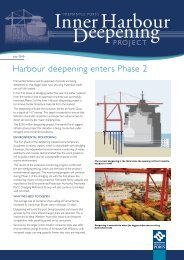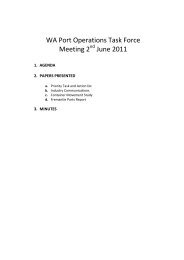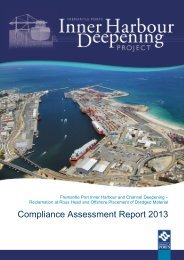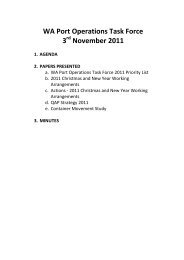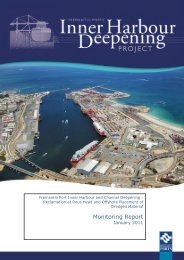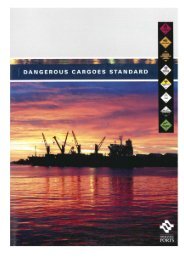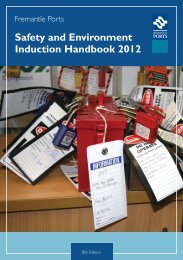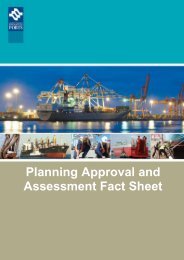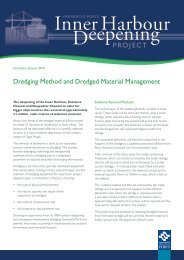Fremantle Port Inner Harbour and Channel ... - Fremantle Ports
Fremantle Port Inner Harbour and Channel ... - Fremantle Ports
Fremantle Port Inner Harbour and Channel ... - Fremantle Ports
Create successful ePaper yourself
Turn your PDF publications into a flip-book with our unique Google optimized e-Paper software.
o<br />
o<br />
Management measures shall be implemented to neutralise return water to<br />
within acceptable pH range.<br />
Return water discharge shall cease until it can be demonstrated that no risk to<br />
the environment is posed from unacceptably low (or high) water pH.<br />
Dissolved Oxygen within proximity of <strong>Inner</strong> <strong>Harbour</strong> Dredge, Return Water, Offshore<br />
Dredge <strong>and</strong> Disposal Plumes<br />
Frequency<br />
• Baseline prior to dredging or discharge of reclamation water, then weekly (or<br />
fortnightly at <strong>Inner</strong> <strong>Harbour</strong> sites monitored by DoW) until the completion of dredging<br />
or reclamation <strong>and</strong> conclusion of return water discharge, <strong>and</strong> one week thereafter or<br />
until water quality meets relevant criteria.<br />
• Monitoring will be targeted <strong>and</strong> focussed on data collection at those sites within<br />
proximity of the visible plume/s (as based on field observation <strong>and</strong> aerial imagery),<br />
which technically defines the potential zone of influence, plus associated reference<br />
sites. That is, not all sites may be sampled, <strong>and</strong> to reiterate for emphasis, when<br />
dredging only those sites within proximity of the visible dredge, disposal <strong>and</strong>/or return<br />
water plumes will be sampled, plus associated reference sites.<br />
Location<br />
Total of twenty-one sites including:<br />
• Four ‘dynamic transect’ sites within the <strong>Inner</strong> <strong>Harbour</strong> dredge plume (at distances<br />
10 m, 50m, 100 m <strong>and</strong> 500 m from dredge head) as detailed in Section 3.3,<br />
Figure 3.1 <strong>and</strong> Figure 3.2 (N.B. ‘mock’ sites at the same distances of separation along<br />
a transect within the <strong>Inner</strong> <strong>Harbour</strong>, at a r<strong>and</strong>om location overlying the footprint of<br />
potentially contaminated sediment, shall be used for (i) baseline sampling <strong>and</strong> (ii)<br />
water quality sampling in the week subsequent to dredging of that sediment, if the<br />
dredge has moved out of the <strong>Inner</strong> <strong>Harbour</strong>).<br />
• Six sites including one site within the reclamation pond, one site within the weir box,<br />
three ‘dynamic transect’ sites within the return water plume (at distances 10 m,<br />
200 m <strong>and</strong> 500 m from silt curtain) <strong>and</strong> two ‘static reference’ sites within the<br />
Cottesloe Reef Fish Habitat Protection Area, as shown in Figure 3.1 (N.B. ‘mock’ sites<br />
at the same distances of separation along a transect offshore of the return water<br />
discharge outlet / weir box, shall be used for (i) baseline sampling <strong>and</strong> (ii) water<br />
quality sampling in the week subsequent to conclusion of return water discharge).<br />
• Three water quality sites surrounding the <strong>Inner</strong> <strong>Harbour</strong>, monitored by the DoW, as<br />
detailed in Section 3.6 <strong>and</strong> Figure 3.1 (N.B. salinity <strong>and</strong> total nutrients will also be<br />
monitored by the DoW at these sites for contextual purposes).<br />
• Eight ‘dynamic transect’ sites within the offshore dredge plume (4 sites) <strong>and</strong> disposal<br />
plume (4 sites) (at distances 10 m, 50m, 100 m <strong>and</strong> 500 m from dredge head or<br />
location of spoil disposal) as detailed in Section 3.4 <strong>and</strong> Figure 3.1 (N.B. ‘mock’ sites<br />
at the same distances of separation along a transect within the offshore deep water<br />
channel <strong>and</strong> disposal area, at a r<strong>and</strong>om location overlying the footprint of sediment to<br />
be dredged <strong>and</strong> disposed shall be used for (i) baseline sampling <strong>and</strong> (ii) water quality<br />
sampling in the week subsequent to dredging <strong>and</strong> disposal of that sediment).<br />
Method<br />
• Measure daytime DO saturation within bottom waters (0-50 cm from sediment<br />
surface) at each site every week (or fortnight at DoW sites) in accordance with EPA<br />
(2005a,b).<br />
• For contextual purposes TSS concentration will also be determined at each location by<br />
collection of a single integrated-depth water sample, sent to a NATA-accredited<br />
laboratory for analysis of the concentration <strong>and</strong> determination of the organic<br />
component via loss on ignition (LOI).<br />
• For contextual purposes the water turbidity (NTU) <strong>and</strong> temperature profile will also be<br />
measured at each location.<br />
• For contextual purposes, Secchi depth will also be measured at each site in<br />
accordance with EPA (2005a,b).<br />
• Compare rolling 2-week median DO saturation of bottom waters at each potential<br />
impact site against EQG triggers for moderate <strong>and</strong> high protection as listed in<br />
Table 4.4.<br />
24 Oceanica: <strong>Fremantle</strong> <strong>Port</strong>s: <strong>Inner</strong> <strong>Harbour</strong> <strong>and</strong> <strong>Channel</strong> Deepening - Water Quality Monitoring Program



